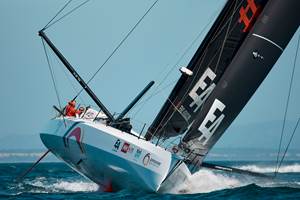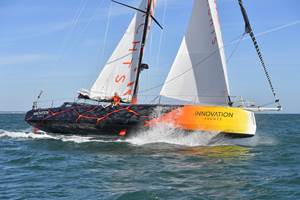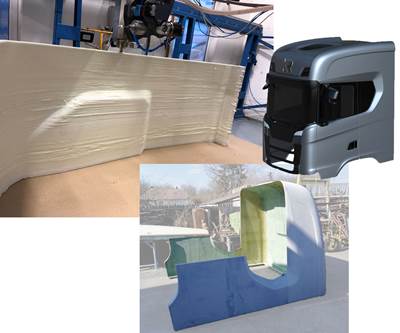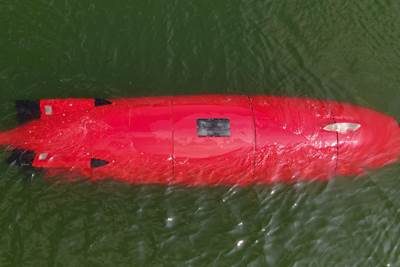
A 3D printed block is being CNC milled for a boat plug used to manufacture a composite mold for a boat hull. Source | Foarboc Ltd.
Additive manufacturing (AM) technology has introduced innovation into various areas of manufacturing and is particularly suitable for automating processes that traditionally required painstaking, intensive hours of manual labor. More specifically, operators have found ways to integrate large-format additive manufacturing (LFAM) to replace not just one, but several steps in the part production process.
For example, Rapid Prototyping (Budapest, Hungary), a manufacturer of large prototype structures for more than 20 years, has seen success using LFAM to produce a variety of parts and tooling, showcasing the technology’s versatility and efficiency in modern manufacturing.
For years, Rapid Prototyping, which is owned by Foarboc Ltd. (Budapest), had been manufacturing molds from CNC-machined polyurethane foam and hand-laid glass fiber-reinforced plastic (GFRP). In 2020, the company was one of the first customers to acquire a standalone pellet extruder from LFAM supplier CEAD (Delft, Netherlands).
The E25 robot extruder was integrated with the company’s Big Blue, a 4,850 × 2,635 × 1,460-millimeter gantry CNC machine. With its CNC machine now transformed into a large-format 3D printer, Rapid Prototyping started manufacturing molds and prototypes using 30% short glass fiber-reinforced polypropylene for various applications in the yacht and marine industries, custom truck manufacturers and other related industries.
According to György Juhász, owner of Rapid Prototyping and Foarboc Ltd., this change in materials and process cut back the company’s labor time by up to 50% while also notably reducing overall lead times.
Case study: Faster, more sustainable boat plug production
For example, Rapid Prototyping has integrated 3D printing into its production process for manufacturing plugs that are used to build fiberglass molds for boat hulls.
Previously, the company produced boat plugs by milling foam blocks to the correct shape. The procurement of these blocks relied on an external supplier, which often caused delays in generating client offers. Waiting for quotations and facing potential stock shortages at the supplier level typically led to a minimum 2-week lead time simply for foam block delivery. Occasionally, the team also had to construct larger blocks from the ones they received before they could start the milling process because the supplier lacked the required size.
After acquiring the CEAD extruder, the company began looking at ways to use AM to reduce lead times and materials supply bottlenecks for its boat plug production.
The first, immediate benefit is that instead of waiting for foam blocks to be delivered from an external supplier, Rapid Prototyping is now able to keep a stock of pellet material and start production at any time. Juhász says that the world has learned that supply chains are tremendously susceptible to global disruptions, underscoring the need for resilient strategies and adaptable frameworks. In this case, Rapid Prototyping is able to localize production by using LFAM for on-demand production without relying on large inventories.
Implementing 3D printing also enabled the company to transition from using polyurethane foam to a sturdier thermoplastic material, Juhász says. “Foam is influenced a lot by cold and warm weather, expanding and shrinking under different circumstances,” he explains. “This leads to more inaccuracies when using the foam plug to create the fiberglass mold, which are difficult to compensate and require more layers of fiberglass to prevent these inaccuracies from affecting the final part.”
The use of 3D printed plugs leads to an improved end product, he says, while requiring fewer layers of fiberglass and paint compared to traditionally manufactured foam plugs.
The company has also optimized its manufacturing workflow. Each plug is printed in multiple pieces using the Big Blue machine with its CEAD extruder. “We mill a baseline and reference points before moving it to another CNC machine for the final finish, while the Big Blue starts a new print,” Juhász explains.
Rapid Prototyping has five CNC machines for finishing that can run simultaneously, he notes, which means that printing smaller pieces that can be machined while the next piece is printing is the most efficient use of the company’s machines.
3D printed blocks are also lighter and easier to handle than medium density fiberboard (MDF) blocks that are used in some applications, which speeds plug assembly.
Once all pieces are printed and milled, they are joined with adhesive and small plastic inserts. When the plug is complete, hand layup is used to make a fiberglass/polypropylene mold from the plug, which will be the basis for manufacturing the final yacht hulls.
In 2022, Rapid Prototyping tested this production process by manufacturing a plug for a 55-foot boat hull. The plug consisted of 44 pieces made from 5,000 kilograms of recycled PETG.
The entire project took 12 weeks for a three-person team. “Before, we would have needed nine people working around the clock to produce the blocks for the plug,” Juhász says. “Now, I only need additional workforce when it’s time to begin assembling the plug.”
He adds that finding skilled labor for plug part production has become increasingly challenging, making the automation facilitated by 3D printing an additional benefit. While the machine is operating, the team is able to more efficiently spend their time on other tasks.
Beyond boat plugs, the company has since begun using 3D printing to manufacture other marine products as well, such as molds and boat components.
Reduced waste and recyclability
In addition to decreasing lead time and increasing production efficiency, one of the primary motivations that led the company to transition to 3D printing was a desire to reduce material waste from conventional manufacturing.
“More than 50% of the material was going to waste by milling the foam blocks into shape, without the possibility to recycle any of it,” Juhász says. By 3D printing blocks to near-net shape, the amount of waste is reduced significantly, he says. The printer also enables use of recycled materials, such as PETG.
The company is also taking the recyclability potential of the technology a step further, by reusing its plugs for additional projects. For example, the 55-foot boat hull plug manufactured in 2022 was shredded, remanufactured into new pellets and used to print a new, 28-foot boat plug with the same recycled material. Juhász explains that the company developed its own machines for shredding and recycling this material.
He adds that the company also powers its machines with solar energy, further demonstrating Rapid Prototyping’s dedication to environmentally responsible manufacturing. “It is possible to start manufacturing in a more sustainable fashion, integrating the principles of the circular economy into the maritime industry. This is an important topic in today’s world,” he says.
Related Content
Alliance for European Flax-Linen and Hemp reports increasing flax fiber adoption in marine
The natural fiber is increasing traction across several marine applications, including in projects by Greenboats, Northern Light Composites, the Beneteau Group and others.
Read MoreRefurbished Einstein yacht demonstrates innovative composites repair and redesign
Years of creative engineering work went into resurrecting the composites-intensive IMOCA 60 racing yacht — with award-winning results.
Read MoreAl Seer Marine, Abu Dhabi Maritime unveil world’s largest 3D-printed boat
Holding the new Guinness World Record at 11.98 meters, the 3D-printed composite water taxi used a CEAD Flexbot to print two hulls in less than 12 days.
Read MoreEuropean boatbuilders lead quest to build recyclable composite boats
Marine industry constituents are looking to take composite use one step further with the production of tough and recyclable recreational boats. Some are using new infusible thermoplastic resins.
Read MoreRead Next
3D printing large composite molds with a 5-axis CNC machine
Hungarian manufacturer uses CEAD Robot Extruder to cut composite tooling time and cost.
Read MoreAdditive manufacturing adds versatility to large marine structures
Dive Technologies and Moi Composites are among those extending composite 3D printing’s design flexibility past prototyping and into customizable end-use parts.
Read MoreVIDEO: High-volume processing for fiberglass components
Cannon Ergos, a company specializing in high-ton presses and equipment for composites fabrication and plastics processing, displayed automotive and industrial components at CAMX 2024.
Read More

.jpg;width=70;height=70;mode=crop)
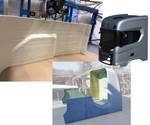










.jpg;maxWidth=300;quality=90)





